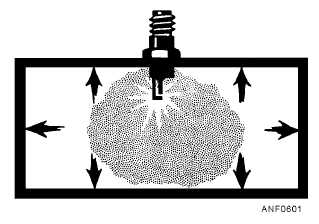CHAPTER 6
AIRCRAFT POWER PLANTS
INTRODUCTION
All naval aircraft are engine driven. The early
engines were all reciprocating engines. Today, almost
all are jet propulsion engines. Therefore, this chapter
covers only jet propulsion engines.
The jet propulsion principle is the basic concept for
the gas turbine engine. This principle is not a new
concept. Sea creatures use jet propulsion to propel
themselves through the water. The Egyptians built the
first reaction engine around 250 BC. Between 1700 and
1930,
technical
achievements
in
engineering,
manufacturing, and metallurgy made the reaction
principle applicable to the development of the gas
turbine engine for jet propulsion. In 1939, the Germans
flew the first aircraft powered by a gas turbine engine,
followed by the British in 1941, and the Americans in
1942. During World War II, Germany was the only
nation to fly a gas turbine-propelled aircraft in actual
combat.
There are four types of jet propulsion engines: the
rocket, the ramjet, the pulsejet, and the gas turbine
engine. Of these, the gas turbine engine powers almost
all naval aircraft. There are four types of gas turbine
engines: the turbojet, the turbofan, the turboprop, and
the turboshaft. The turbojet and turbofan engines use
thrust directly. The turboprop and turboshaft engines
use thrust to deliver torque (turning power) to an
airplane propeller or a helicopter rotor. Regardless of
the type, the purpose of an engine is to develop thrust.
This chapter will give you basic information on jet
propulsion engines.
JET PROPULSION ENGINES
LEARNING OBJECTIVE: Recognize the
basic operating principles for the four types of
jet propulsion engines, and identify the
components and functions of each type of
engine.
A jet propulsion engine projects a column of air to
the rear at extremely high speeds. The resulting thrust
pushes the aircraft in the opposite (or forward)
direction. Jet propulsion engines are grouped into four
main types:
1.
Rocket. These are jet propulsion systems that
do not use atmospheric air.
2.
Ramjet. The ramjet operates as a continuous
thermal duct or athodyd.
3.
Pulsejet.
The
pulsejet
operates
as
an
intermittent impulse duct.
4.
Gas turbine. The gas turbine engine operates as
a continuous turbine-compressor unit.
ROCKET ENGINES
The rocket uses a form of jet propulsion that differs
in basic ways from thermal gas turbine systems. The
rocket does not draw air from the outside to fuel the
combustion process. It carries with it both the fuel and
the oxidizer for combustion. This is a disadvantage for
atmospheric flight, but it is the only way at present to
fuel flight outside the earth's atmosphere. The rocket is
a true jet reaction unit. A brief examination of its
functions clarifies the reaction principle by which all
thermal jet units operate.
If you burn a hydrocarbon (compound containing
only hydrogen and carbon) in a closed container (fig.
6-1), the heat of the burning fuel is released, causing the
trapped gases to expand rapidly. Because the container
has a closed volume, the temperature and pressure rises
and is uniformly distributed (balanced) in all directions.
Since the force of the rising pressure cannot be released
and is balanced, the container does not move.
6-1
Figure 6-1.—Combustion in a closed container.

